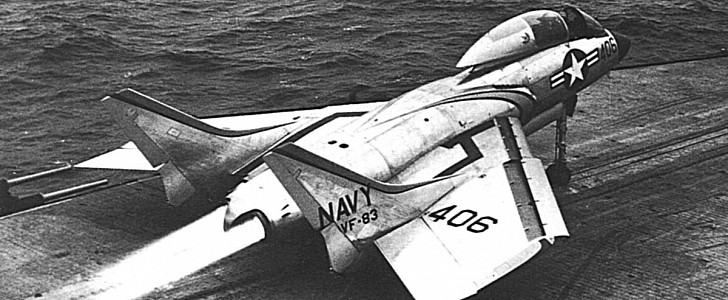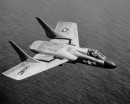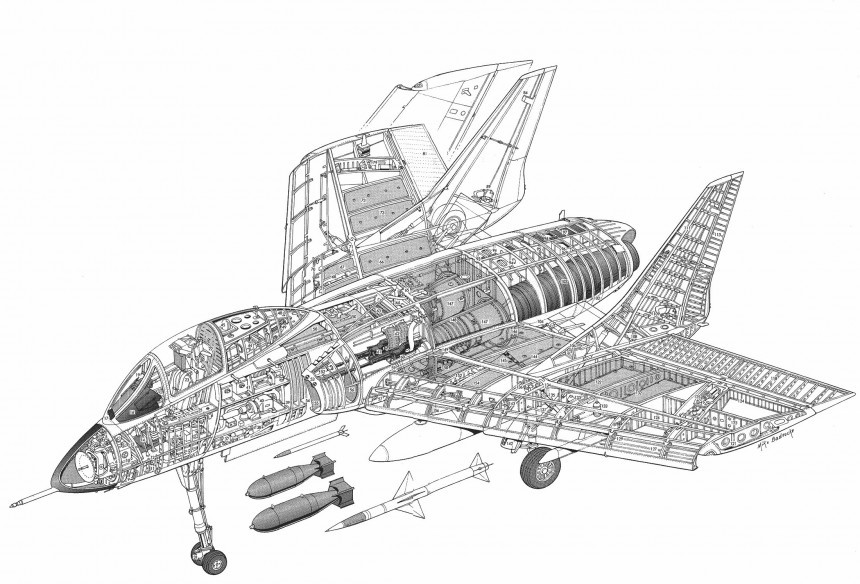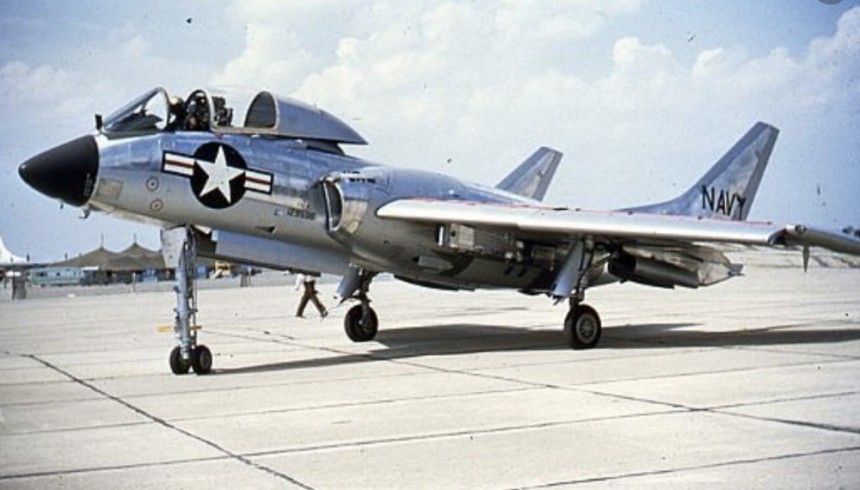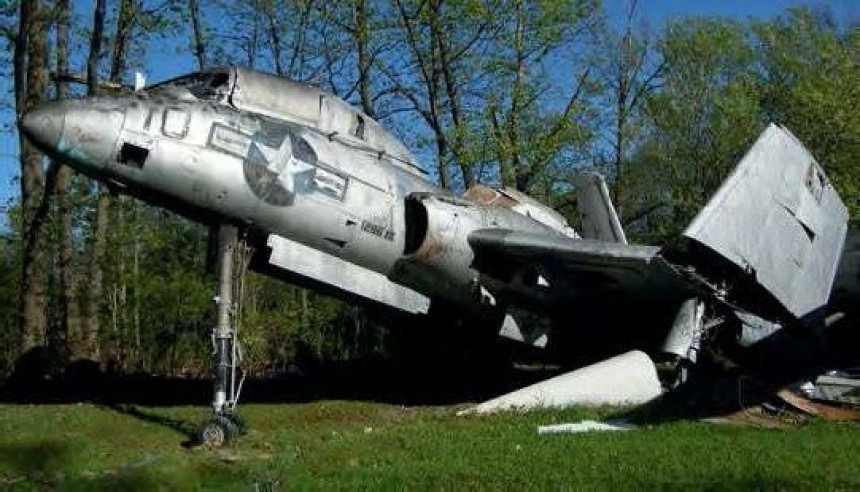Form doesn't always follow function when it comes to fighter jets. Even planes that look like spaceships and feature the latest technology can have too much hope invested in them far too quickly. Such is the case with the Vought F7U Cutlass.
The story of this stunning-looking single-seat, twin-engined, carrier-based fighter jet dates back to the end of the Second World War. After this conflict, the victorious Allies, mostly the British, Soviets, and Americans, helped themselves to all the tasty classified German aerospace technology. Legend has it that the Germans were as much as a decade or more further advanced in their experimental technology over the Americans.
The small group of German jet fighters that did manage to see combat before the end of the war turned out to only be the tip of the iceberg. One tailless twin-engined turbojet fighter from the Messerschmitt AG senior designer Woldemar Voigt was among the blueprints collected from German scientists. The project was dubbed P.1112 by the Germans.
Voigt was a key designer in the development of the Messerschmitt Me-262 jet fighter and Me-163 Komet rocket interceptor. The Chance Vought aerospace company would contract him to bring something very close to what his initial design looked like back in Germany. The new fighter was dubbed the Cutlass, after the iconic sword often sported by 17th and 18th century pirates.
As it happened, the Cutlass wound up plundering reserve U.S Navy test pilots with its appalling safety record, poor reliability, and other miscellaneous snafus having to do with its out-of-this-world design. The Navy would have to learn the hard way just how deadly the Cutlass was to become, as we're about to show you.
The F7U made its maiden flight in 1948. For an aircraft that would lose a quarter of its rolling stock to accidents, many of them fatal, the Cutlass had a fairly trouble-free first few test flights. Many politicians, Navy personnel, and Senior Officers had quite a bit of stock in being every bit of the formidable carrier defense fighter its German forbearer thought it could be.
Though Chance Vough Co. denied any involvement with their old German rivals, they couldn't keep up the charade forever. Even a cursory glance at a mockup of the P.1112 compared to the F7U made it clear where its origins lie. Most simply brushed this aside when they got one good look at the stunning good looks of the new fighter.
Twin Westinghouse J-46 afterburning turbojet engines matched the sports car styling. The radical tailless design used alternative forms of control surfaces to dictate yawing movements, usually handled by a rudder. The wings' leading edge was fitted with aerodynamically deployed slats to help cut through the air in tight maneuvers with a bit more ferocity.
The plane was armed with four M3 20mm cannons and mounting points for four Sparrow air-to-air missiles under the wings. But the Cutlass would never be deployed in combat, due in large part to the comedy of mishaps that began soon after flight testing commenced. The Westinghouse engines were prone to flameout at very inopportune times, for starters.
We're talking like during takeoff and landings on aircraft carriers. If a pilot was unable to maintain thrust during carrier landing, their best bet was to bail out before the plane impacted the side of the ship or touched down with such force that it folded the landing gear, breaking bones in the process.
A few crashed F7Us even exploded with pilots still inside, a sickening notion but all too common on the Cutlass. Furthermore, the aircraft was unable to break the sound barrier. This was also true of Soviet Jet fighters of the era like the Yak-15 and MiG-15. But then again, the MiG-15 didn't bend its landing gear like a piece of plywood if touchdown forces are a bit above normal.
After 78 accidents and 55,000 total fleet flight hours, the Cutlass was slated for replacement by the then brand new Grumman F9F Panther and swept-winged F9 Cougar. To say Navy pilots adored these new planes was an understatement.
So then, so much for advanced German engineering. If anything, the Cutlass only served to prove that it was Grumman of Long Island, New York, who built the world's finest Navy fighters. No ifs, ands, or buts about it.
Check back soon for more unique and quirky military aircraft profiles right here on autoevolution.
The small group of German jet fighters that did manage to see combat before the end of the war turned out to only be the tip of the iceberg. One tailless twin-engined turbojet fighter from the Messerschmitt AG senior designer Woldemar Voigt was among the blueprints collected from German scientists. The project was dubbed P.1112 by the Germans.
Voigt was a key designer in the development of the Messerschmitt Me-262 jet fighter and Me-163 Komet rocket interceptor. The Chance Vought aerospace company would contract him to bring something very close to what his initial design looked like back in Germany. The new fighter was dubbed the Cutlass, after the iconic sword often sported by 17th and 18th century pirates.
As it happened, the Cutlass wound up plundering reserve U.S Navy test pilots with its appalling safety record, poor reliability, and other miscellaneous snafus having to do with its out-of-this-world design. The Navy would have to learn the hard way just how deadly the Cutlass was to become, as we're about to show you.
Though Chance Vough Co. denied any involvement with their old German rivals, they couldn't keep up the charade forever. Even a cursory glance at a mockup of the P.1112 compared to the F7U made it clear where its origins lie. Most simply brushed this aside when they got one good look at the stunning good looks of the new fighter.
Twin Westinghouse J-46 afterburning turbojet engines matched the sports car styling. The radical tailless design used alternative forms of control surfaces to dictate yawing movements, usually handled by a rudder. The wings' leading edge was fitted with aerodynamically deployed slats to help cut through the air in tight maneuvers with a bit more ferocity.
The plane was armed with four M3 20mm cannons and mounting points for four Sparrow air-to-air missiles under the wings. But the Cutlass would never be deployed in combat, due in large part to the comedy of mishaps that began soon after flight testing commenced. The Westinghouse engines were prone to flameout at very inopportune times, for starters.
A few crashed F7Us even exploded with pilots still inside, a sickening notion but all too common on the Cutlass. Furthermore, the aircraft was unable to break the sound barrier. This was also true of Soviet Jet fighters of the era like the Yak-15 and MiG-15. But then again, the MiG-15 didn't bend its landing gear like a piece of plywood if touchdown forces are a bit above normal.
After 78 accidents and 55,000 total fleet flight hours, the Cutlass was slated for replacement by the then brand new Grumman F9F Panther and swept-winged F9 Cougar. To say Navy pilots adored these new planes was an understatement.
So then, so much for advanced German engineering. If anything, the Cutlass only served to prove that it was Grumman of Long Island, New York, who built the world's finest Navy fighters. No ifs, ands, or buts about it.
